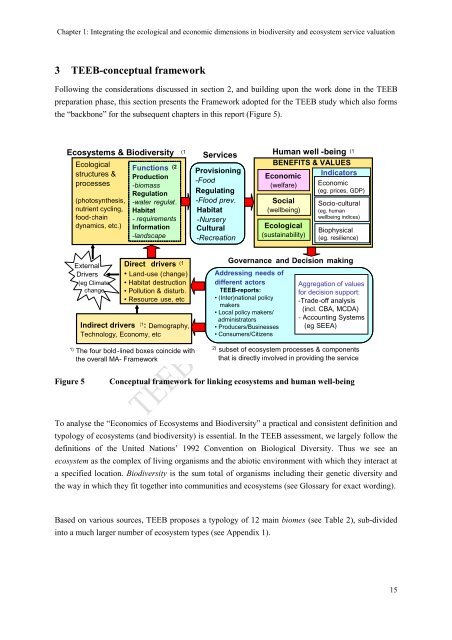Chapter 1 Framework of integration of ecology and economy ... - TEEB
Chapter 1 Framework of integration of ecology and economy ... - TEEB
Chapter 1 Framework of integration of ecology and economy ... - TEEB
You also want an ePaper? Increase the reach of your titles
YUMPU automatically turns print PDFs into web optimized ePapers that Google loves.
<strong>Chapter</strong> 1: Integrating the ecological <strong>and</strong> economic dimensions in biodiversity <strong>and</strong> ecosystem service valuation3 <strong>TEEB</strong>-conceptual frameworkFollowing the considerations discussed in section 2, <strong>and</strong> building upon the work done in the <strong>TEEB</strong>preparation phase, this section presents the <strong>Framework</strong> adopted for the <strong>TEEB</strong> study which also formsthe “backbone” for the subsequent chapters in this report (Figure 5).Ecosystems & Biodiversity (1Services Human well - being (1EcologicalBENEFITS & VALUESstructures &ProvisioningEconomicIndicatorsprocesses- Food(welfare) EconomicRegulating( eg . prices, GDP)(photosynthesis,nutrient cycling,food - chaindynamics, etc.)Functions (2Production- biomassRegulation- water regulat .Habitat- requirementsInformation- l<strong>and</strong>scape- Flood prev.Habitat- NurseryCultural- RecreationSocial(wellbeing)Ecological(sustainability)Socio - cultural( eg . humanwellbeing indices)Biophysical( eg . resilience)ExternalDrivers( eg ClimatechangeDirect drivers (1• L<strong>and</strong> - use ( change )• Habitat destruction• Pollution & disturb .• Resource use , etcIndirect drivers (1 : Demography,Technology, Economy, etc1) The four bold - lined boxes coincide withthe overall MA- <strong>Framework</strong>Governance <strong>and</strong> Decision makingAddressing needs <strong>of</strong>different actors<strong>TEEB</strong> - reports :• ( Inter)national policymakers• Local policy makers /administrators• Producers/Businesses• Consumers/CitizensAggregation <strong>of</strong> valuesfor decision support:- Trade - <strong>of</strong>f analysis(incl. CBA, MCDA)- Accounting Systems( eg SEEA)2) subset <strong>of</strong> ecosystem processes & componentsthat is directly involved in providing the serviceFigure 5Conceptual framework for linking ecosystems <strong>and</strong> human well-beingTo analyse the “Economics <strong>of</strong> Ecosystems <strong>and</strong> Biodiversity” a practical <strong>and</strong> consistent definition <strong>and</strong>typology <strong>of</strong> ecosystems (<strong>and</strong> biodiversity) is essential. In the <strong>TEEB</strong> assessment, we largely follow thedefinitions <strong>of</strong> the United Nations‟ 1992 Convention on Biological Diversity. Thus we see anecosystem as the complex <strong>of</strong> living organisms <strong>and</strong> the abiotic environment with which they interact ata specified location. Biodiversity is the sum total <strong>of</strong> organisms including their genetic diversity <strong>and</strong>the way in which they fit together into communities <strong>and</strong> ecosystems (see Glossary for exact wording).Based on various sources, <strong>TEEB</strong> proposes a typology <strong>of</strong> 12 main biomes (see Table 2), sub-dividedinto a much larger number <strong>of</strong> ecosystem types (see Appendix 1).15
















